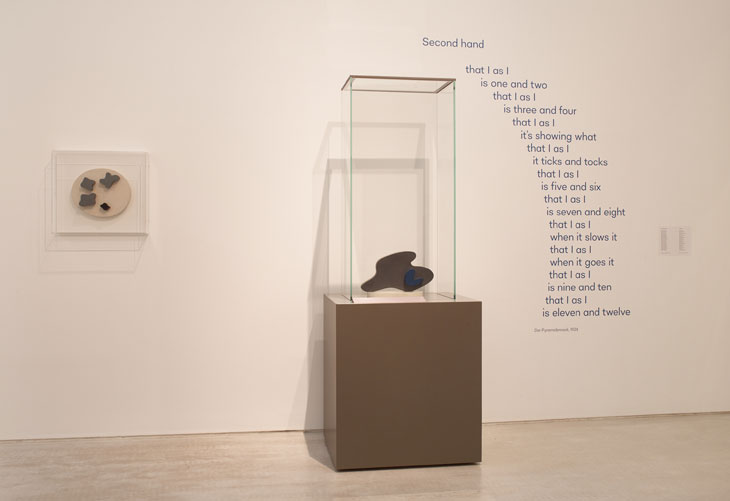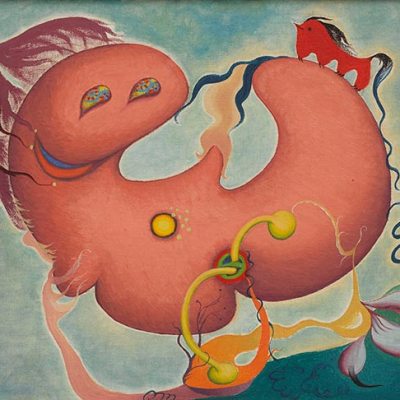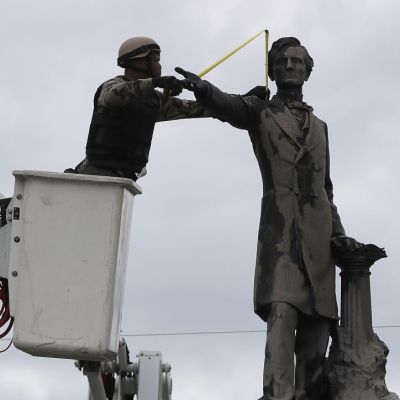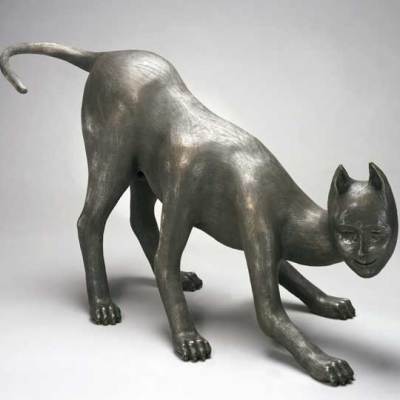On Margate sands, the sky seemed to be doing something Turner might have appreciated. But for me, the sea was doing something different altogether. Taken in from the vast windows of the Turner Contemporary, which has dedicated two of its gallery spaces to a retrospective of Jean Arp’s works, the sea’s expanse seemed to open out to France, Belgium, Holland – a fitting reflection of the dynamic internationalism of this sculptor-poet’s long career.
Born and brought up in the Franco-German border region of Alsace – which had been pushed and pulled between empires for centuries, and would change hands four more times between 1871 and 1945 – Arp was no stranger to the notion that nationhood might not be as rigid as the fractious politicians of early 20th-century Europe made out. For Arp, whose own name altered with each passing occupation (from Jean to Hans, French to German), the boundaries of self were as permeable as his homeland’s borders. Forcing momentous shifts in the geography of his family’s existence, the upheavals that plagued the people of Alsace, like the World Wars that accompanied them, would reverberate through Arp’s artistic experiments throughout his career.
With the outbreak of the First World War, Arp’s German citizenship made him a target for conscription into the German army. Fleeing to Paris and then to neutral Switzerland, where he settled in Zürich, the young Arp quickly fell in with a group of artists who abominated the war and the rationalistic cultural milieu that had made it possible. It was here, among this internationalist group (the Dadaists), that he began experimenting with the signs and symbols of an artistic vocabulary capable of transcending language’s barriers.
Arp with Navel-Monocle (c. 1926), Jean (Hans) Arp. Stiftung Arp e.V., Berlin/Rolandswerth

These bold early emblems greet us towards the beginning of Turner Contemporary’s exhibition. Lithographed hieroglyphs in black and white, they partake of witty social critique even while forming a kind of manifesto for Arp’s distinctly organic brand of artistic subversion. Chapeau moustache / Schnurrhut / Snorhoed / Moustache-hat (1923) reveals an acute disdain for the pomposity of bourgeois culture, but with a quirky humour which makes dissent inventive and social order something to be metamorphosed into new, surprising shapes.
Elsewhere, the series reveals a burgeoning preoccupation with natural centres and natal beginnings. La bouteille-nombril / Die Nabelflasche / De navelfles / The navel-bottle (1923) situates the annular point of the belly button as the focus of a crudely shaped black bottle which leans precariously. There’s a natural nucleus to this eccentric object, and with it the suggestion that the abstract or seemingly whimsical convergence of disparate elements constitutes a kind of birth and growth – a blossoming of hybridity.
The multilingual titles to these pieces, and their playful fusions, also gesture towards the essentially linguistic nature of Arp’s project, and his inclination to a cross-pollination between verbal and visual media. In fact, one of the exhibition’s triumphs is the way it artfully brings Arp’s Dada and concrete poetry into dialogue with his collages, sculptures, and word-objects. The juxtaposition, for instance, of the poem ‘Second Hand’ with the flowing Hand Fruit / Fruit d’une main / Handfrucht (1927–28) reveals the material and semantic textures that word and artwork, respectively, might gain through the artist’s feeling for repetition, layering, and gradual accumulation. ‘that I as I / is one and two / that I as I / is three and four / that I as I / it’s showing that / that I as I / in ticks and tocks / that I as I / is five and six’: this particular poem reminds, us, too, that with the gatherings of words and languages, and the accrual of materials, comes an ever richer and more complex subject.
‘Arp: The Poetry of Forms’, installation view at Turner Contemporary, Margate, 2017. Photo: Stephen White, courtesy Turner Contemporary

Indeed, if we’re introduced to Arp’s word-objects from the exhibition’s beginning, one of the most compelling aspects of this sweeping retrospective is watching Arp repeat shapes and words that gain new meanings over time. Time isn’t strictly chronological in this exhibition: the inclusion of so much of Arp’s sculpture means that, while mounted prints, collages, and wood assemblages guide us through periods of his progress, our wanderings amid his bronzes and plaster sculptures brings a pleasing fluidity to the way we view the work.
Just as our understanding emerges through undirected encounters with his works, Arp’s later experiments in collage are evidence of his growing concern with just this sort of organic experience. As pieces like According to the Laws of Chance (1933) and Torn-Up Woodcut (a rearrangement from 1954 of a Dada print from three decades earlier) make clear, the artist came increasingly to believe that his creations must be as subject to chance as natural creation is. Moving beyond social commentary, Arp’s later ‘constellations’ and ‘concretions’ testify to his devotion to an enhanced relationship between observer, artwork, and natural process; his visual language came, then, to transcend the social and political in its search for the natural forces that shape our lives.
‘Arp: The Poetry of Forms’, installation view at Turner Contemporary, Margate, 2017. Photo: Stephen White, courtesy Turner Contemporary

This isn’t to say that Arp’s works don’t verge on the disruptive or the destructive. One of the downsides of this extensive exhibition is that, occasionally, our sense of Arp as a developing artist, responding over time to political disaster and personal loss, is muted by profusion. The relationship between Arp and his wife and collaborator is charted, and her death is mentioned in reference to the poignant pieces that he produced from their collaborative artworks, which he tore-up, rearranged, and overlaid with mottled colour. That account of pain, however, is fleeting, and the exhibition’s chronological idiosyncrasies, while often effective, can distort our notion of this man’s story, the complex and changing self behind the wit and charm, inventiveness and spark.
A similar contextual difficulty arises when facing Arp’s remarkable sculptures. Here, biomorphic lines are intended not only to reflect the organic world, but to engage in dialogue with it: many of these pieces find their fullest meaning within a natural setting – much like Henry Moore’s undulating bodies or Barbara Hepworth’s vital spirals. While Moore’s pieces are perhaps best viewed in situ at Perry Green, Hepworth’s outdoor pieces were given new life within the gallery setting at Tate Britain’s ‘Sculpture for a Modern World’ in 2015, which included a life-size reconstruction of one of her modern architectural structures in which she showed her work.
Space doesn’t always permit such luxuries. But in Margate, the brief glimpse of Arp walking outdoors amongst trees and sculptures, conveyed on a small video screen outside exhibition galleries, made me wonder if large photographs of his works out in the world might have provided an aid to appreciation – or, indeed, if the sea seen from through the building’s windows was more than enough context already. For Arp’s work surely deserves our appreciation today. Caught up in the fractious identity politics of Brexit, and at a moment when the alliances between nations grow ever more unstable, Arp’s unique union of the verbal with the visual must surely remind us of the richness of internationalism, of hybridity in all its forms. For this reason, and many more, Turner Contemporary’s exhibition makes for essential viewing.
‘Arp: The Poetry of Forms’ is at Turner Contemporary, Margate, until 14 January 2018.



